Garden cranberry. Types of cranberries: common, large-fruited, small-fruited. What are the benefits of cranberries and contraindications. Where do cranberries grow?
It is easiest to grow cranberries in peat garden plots - in this case, only a minimal amount of phosphorus fertilizer is enough, and mineral fertilizing may not be required at all.
How does garden cranberry grow and when does it bloom?
garden cranberry– an evergreen lodging shrub of the lingonberry family, up to 80 cm high, with long creeping and short erect or raised shoots. Creeping shoots can be from 0.2 to 1 m long, and erect shoots can be from 3 to 15 cm. The adventitious roots are thin. Garden cranberries grow like wild cranberries - their root system is superficial, located at a depth of 5-15 cm with highly developed mycorrhiza (symbiosis of a fungus with a plant), which makes it possible to better use nutrients from the soil.
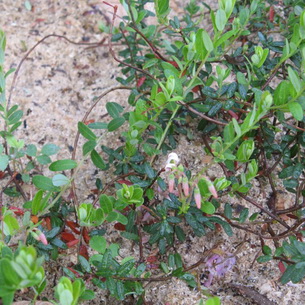
The stems are filamentous, highly branched, and sometimes rooted. The leaves are small, leathery, oblong-ovate, green above, silvery below, covered with a waxy coating. Cranberry leaves live for 2–3 years, with a thick waxy coating on top and a silvery tint underneath.
When does garden cranberry bloom in cultivation? At the ends of the short, erect shoots there are bell-shaped pale pink flowers, collected in racemes. Flowering occurs in May - June, cross-pollination with the help of insects. The flowers are small, whitish-pink, drooping, located on long stalks at the ends of the shoots. The fruit is a dark red spherical-oblong berry with juicy pulp.
As you can see in the photo, garden cranberries have berries up to 2.0 cm in diameter, dark red, with sour red flesh, containing from 6 to 20–30 small seeds:

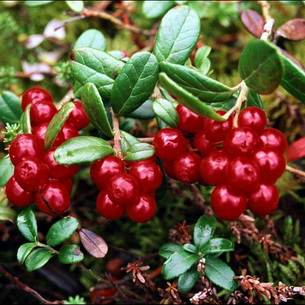
The berries ripen in September and early October. Due to their high acidity, as well as the presence of benzoic acid, they are well preserved on the plant throughout the winter. Berries picked from the bush after the onset of frost are especially good, but after thawing they quickly deteriorate.
Cranberry plantations can live up to 60, and sometimes more, years. Cranberries produce their first harvest in the third or fourth years after planting.
How to plant and grow garden cranberries on the plot, how to feed the soil

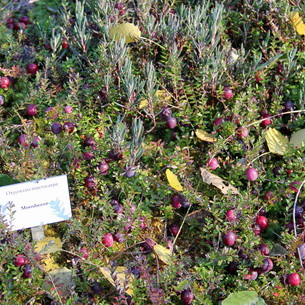
Swamp cranberry (Oxycoccus palus fris) And large cranberries (Oxycoccus macrocarpa) propagated by seed and vegetative methods (cuttings). In breeding work when creating new varieties and in amateur gardening, cranberries are mainly sown. To propagate garden cranberries, seeds from spring-picked berries, after overwintering, undergo natural stratification under the snow and germinate well in the spring.
How to plant and grow garden cranberries on a plot to reap a good harvest? To grow plants, select a lighted place near a water source. In this case, it is necessary to provide for the possibility of briefly flooding the area and draining excess water.
Cranberries have increased requirements for aeration and organic matter content in the soil. Garden cranberries tolerate soils that are poor in chemical composition, but cannot tolerate heavy and floating soils. The easiest way to grow cranberries is for those gardeners whose plots are located on peat soils. Before planting, it is enough to apply phosphorus fertilizers (20 g of double superphosphate per 1 m2) and, when digging, select the rhizomes of perennial weeds.
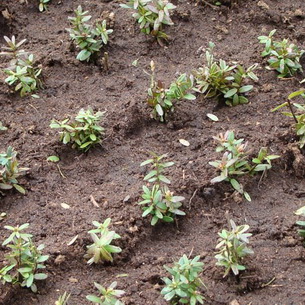
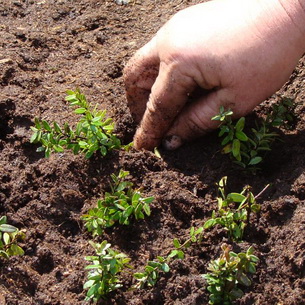
The optimal time for planting is spring, when the plants are in the budding phase or the beginning of shoot growth (the first ten days of May); During autumn planting, plants may freeze. To allow the soil to settle, water it well 1–2 days before planting. When caring for plants, you should prevent the area from becoming overgrown with weeds, especially in the first years, when the shoots have not yet covered the entire area. Weeding is carried out 3-4 times during the growing season on weed seedlings, carefully, trying not to pull out rooted cuttings along with them.
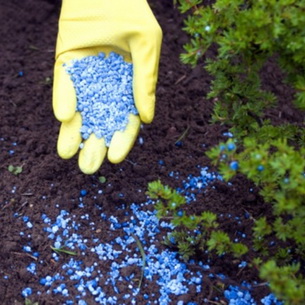
![]()
How to feed garden cranberries on the plot to ensure excellent fruiting? This plant is undemanding in terms of mineral nutrition, but responds positively to low doses of mineral fertilizers. At the same time, fractional (2-3 times per growing season) application of fertilizers, especially nitrogen, is more effective. Do not feed cranberries with manure. When caring for garden cranberries, urea (7–10 g per 1 m2) is added to feed in case of poor plant growth in the year of planting in mid-summer.
Cranberries in the garden begin to bear fruit 3-4 years after planting. Once every 3–5 years, cranberries are rejuvenated. To do this, in late autumn, the surface of the frozen soil is covered with a layer of 2–3 cm of coarse sand or a mixture of sand and high peat (1:1 or 1:2). With proper planting and care of garden cranberries, and good mulching, conditions are created for the formation of a new root system on the stems and the growth of shoots.
Cranberries covered with snow overwinter well. The berries ripen in September – October.
Cranberries are frost-resistant, but in winter, if there is no snow cover or its insufficient thickness, shoots or growth buds may die from frost. In the event of severe frosts, winter drying of plants occurs, since the leaves transpire moisture without being able to replenish its reserves from the frozen soil. Frosts during the period of budding, flowering and fruit set can also lead to the death of the future harvest.
Here you can see photos of planting and caring for garden cranberries in your garden:

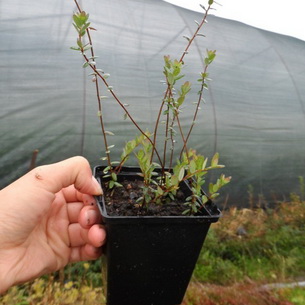
Large-fruited varieties of garden cranberries
Cranberries have long been a wild crop. Of the five types of cranberries, only the large-fruited one, common in North America, and the four-petaled (swamp) one, which is abundant in the northern regions of Russia, are cultivated. American-origin varieties are less frost-resistant, but larger-fruited and more productive. In our country there are regionalized varieties of swamp cranberries, which were created by selecting promising forms from natural populations and selection based on interspecific and intergeneric crossing. In nature, all types of cranberries grow only in swamps.
All released varieties remain resistant to low temperatures (-33 C°) under snow cover. All the varieties of garden cranberries listed below have a susceptibility to snow mold without winter watering of 4 points, with watering - 1 point.
Mid-season

Gift of Kostroma
The berries are large, 1.9 g, sour, without aroma. Contains: sugar 6.0%, acid 3.0%, vitamin C 35 mg%. Tasting score 4 points. Productivity 98.4 c/ha. No pest damage was observed on this large-fruited garden cranberry.

Sazonovskaya
The berries are medium, 0.73 g, sweet and sour. Contains: sugars – 8.1%, acids – 3.0%, vitamin C – 17.0 mg%. Tasting score 4.5 points. Productivity 62.0 c/ha.
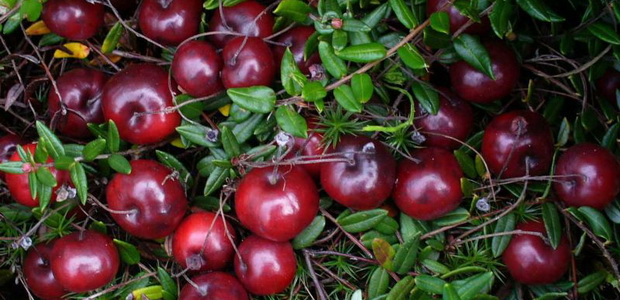
Severyanka
The berries are large, 1.1 g, dark red, sour, without aroma. Contains: sugars – 7.2%, acids – 2.8%, vitamin C – 17.0 mg%. Tasting score 4 points. Productivity 91.0 c/ha.
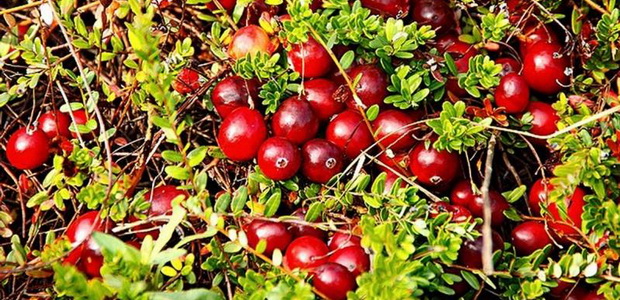
Sominskaya
The berries are large, 0.93 g, lemon-shaped, with an elongated end at the stalk, red, sour, without aroma. Contains: sugars – 7.1%, acids – 3.0%, vitamin C – 32.0 mg%. Tasting score 4 points. Productivity 81.0 c/ha.

Khotavetskaya
The bush is weak-growing, creeping. The berries are large, 0.86 g, round and rounded-flattened, red and dark red, sour without aroma. Contains: sugars – 6.4%, acids – 3.4%, vitamin C – 26.0 mg%. Tasting score 4 points. Productivity 67.4 c/ha.
Late ripening
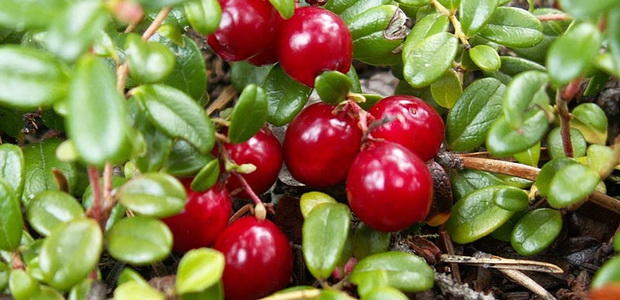
Scarlet Reserve
The bush is weak-growing, creeping. The berries are large, 0.8 g, sour, without aroma. Contains: sugars – 7.3%, acids – 2.9%, vitamin C – 23.0%. Tasting score 4 points. Productivity 75.0 c/ha.

Beauty of the North
The berries are large, weighing 1.5 g, round-oval, pink, sour, without aroma. Contains: sugars – 6.8%, acids – 3.0%, vitamin C – 151 mg%. Tasting score 4 points. Productivity 139.0 c/ha.
How to care for garden cranberries on the site: growing seedlings
Cranberries are planted by cuttings or 1-2 year old seedlings. Depending on the growing conditions, plants begin to bear fruit in the 3rd-5th year. The length of the cuttings is 12–25 cm.
It is better to plant rooted seedlings. They are obtained in nurseries from mother bushes, which are selected among the best based on fruiting results. Seedlings must have no signs of disease or pest damage.
Before caring for garden cranberries, remember that this plant requires good lighting; it also grows in dark areas, but fruiting is sharply reduced.
The soil for cranberries should be acidic - best pH 3–4.5. On heavy soils, it is recommended to remove the top 25x40 cm layer and fill the resulting trench with high-moor peat or a mixture of peat and coarse river sand (5:1) with the addition of 1-2 buckets of leaf or coniferous humus from the forest and 10 g of double or 50 for each square meter g simple superphosphate.
It is better to plant cranberries in the spring, in the first half of May.
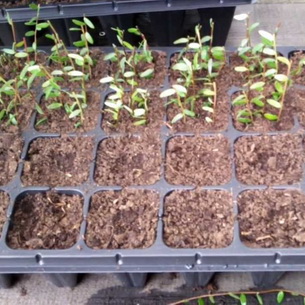

Cranberry cuttings are planted according to a pattern of 25–30×10-15 cm, leaving tops 2–3 cm long above the soil surface. The cuttings are planted with a planting board, deepening them so that tops 2–3 cm long remain above the soil surface. They are planted 2 at a time. -3 per nest, which guarantees the survival of at least 1-2 cuttings in the nest. The cuttings are stuck into the sand and pressed; in the sand the roots develop faster and better). After planting, the plants are watered and subsequently maintain high soil moisture. Before and after planting, the area is well moistened, keeping it moist throughout the rooting process.
It is easier to grow rooted seedlings at a distance of 20–30 cm between rows and 10–15 cm in rows. After planting, the seedlings are watered. Then, in the first week, watering is carried out daily, in the next 2-3 weeks - 2-3 times a week at the rate of 20-30 liters of water per 1 square meter. m, and in subsequent months – 1–2 times a week. After watering, the soil crust is destroyed with a rake.
In the 1st year after planting, the cuttings will form roots and develop several vertical shoots. Creeping shoots are formed during the second year, as well as in the third year. Usually in the third year the entire (or almost entire) surface is covered with developed plants. In the first 3 years, it is very important to carry out timely weed control.
Although cranberries are bog plants, they do not tolerate excessive moisture: the soil should be moist, but not soggy and wet. The optimal water level for cranberries should be between 20–40 cm. Plants can tolerate flooding for up to 30 days, but without watering they do not tolerate prolonged drought very well.
As they grow, the bushes thicken, so periodically it is necessary to clear them of too long vertical shoots and thin them out.
How to grow cranberries in the garden: frost protection
How to grow cranberries in a garden plot in low temperatures? Every year at the beginning of winter the plantation is flooded with water. To do this, pour a layer of 2 cm, after freezing this layer, pour another layer, and so on until the plants are completely frozen into the ice. Overwintering of plants in this state is optimal. In the spring, the water is drained to avoid the spread of snow mold.
When planting and caring for garden cranberries, success in obtaining a harvest of berries depends on measures to protect against frost during the period of budding, flowering and fruit set. Frosts during these periods can lead to partial or complete destruction of the future crop. It is also recommended to temporarily flood the plants, in which the water will cover the flowers and buds until the end of freezing.
Watch the video “Growing Garden Cranberries” to better imagine how all agricultural techniques are performed:
Everyone knows that cranberry is one of the most useful gifts of nature; it is very good in the treatment of many diseases. However, not everyone knows exactly what healing properties it has, where cranberries grow, how and when is the best time to collect them, and how to properly store the berries. This gap needs to be filled.
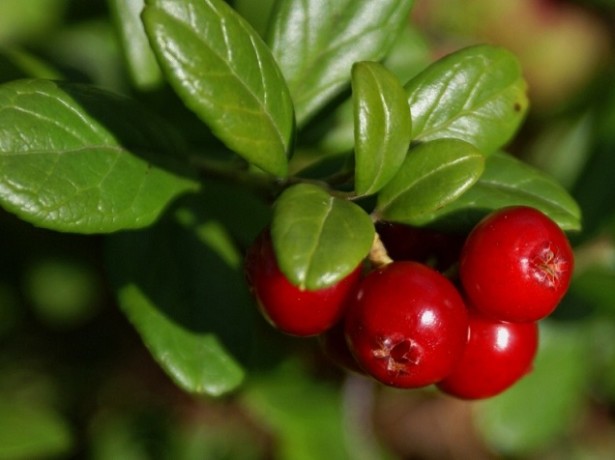
Cranberry fruits contain many rare trace elements
The genus cranberry itself has three types: ordinary, small-fruited, and large-fruited. The latter is sometimes also called American. In Russia, common and small-fruited varieties grow. The second lives mainly near the Arctic Circle, in tundras, forest-tundras, and northern swamps. The common one is found everywhere in wet hollows or swamps throughout Russia, excluding the southern Volga region, Kuban, and the Caucasus. In Europe it grows north of Paris, and in North America - from Chicago, covering all of Canada. The range of the large-fruited variety covers the Appalachian Mountains region.
This berry loves damp places, undisturbed by human activity, and is very sensitive to the state of the environment. So most often cranberries grow in taiga swamps or in wet lowlands and mountain hills. The main thing is that there is enough water and the soil is fertile.
Video about the healing properties of cranberries
Cranberry fruits contain many rare microelements: selenium, lutein, manganese, zeaxanthin. They are used in the treatment of colds and inflammatory diseases, as an antipyretic and suppressant of pathogenic microflora. Cranberry fruits are also used to treat rheumatism and scurvy. Since they contain a lot of vitamins C and K, they are not recommended for consumption by people suffering from stomach ulcers or other diseases of the digestive system. Cranberry juice can act as an irritant.
Before the invention of antibiotics, folk healers used willow bark and cranberry juice; their principle of action is similar to penicillin, although weaker.
People have been collecting healthy berries for a long time. This culture, due to its special distance from human habitation, requires great responsibility and attention from berry growers. It is more difficult to harvest than lingonberries or blueberries. The fact is that it spreads along the soil, intertwined with a carpet of thin branches. In other words, cranberries grow like any marsh grass.
When you come across a cranberry tree, you can’t immediately see where the berries are, which look like ruby beads. They are hidden almost right next to the soil under the greenery. For ease of collection, people use special long combs made of wood or bone. Lifting the branches with them makes it very convenient to remove berries from the plant.
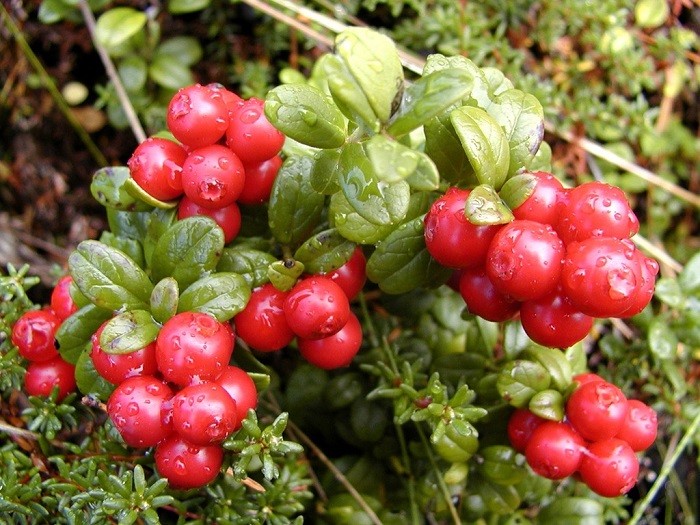
When you come across a cranberry tree, you can’t immediately see where the berries are, they look like ruby beads
The harvest ripens late, later than all other forest berries. Can be collected until the winter cold. Frosts are not scary for her.
Now let's look at step-by-step instructions for storing cranberries:
- Wash the berries, remove crushed, damaged, overripe ones
- We prepare an enamel bucket or large jar, thoroughly wash the container with soda and no other detergents.
- Pour containers with water reserve into the washed container.
- Fill everything with cold boiled water so that the berries are hidden. The water level should be about two centimeters above the berries.
- Cover the top with parchment and tie it with a tourniquet.
- Place the soaked berries in a cool room, out of direct sunlight.
In this form, the fruits will be stored all winter, without losing either taste or usefulness. There are variations of this recipe for storing cranberries. This is soaking in sugar syrup. All steps are similar to those above, only we use cold syrup instead of water. You can also store the crop under pressure. The berries, laid out in containers and filled with water, are pressed down with a wooden circle, on top of which a load is placed. Also keep this in a cool place.
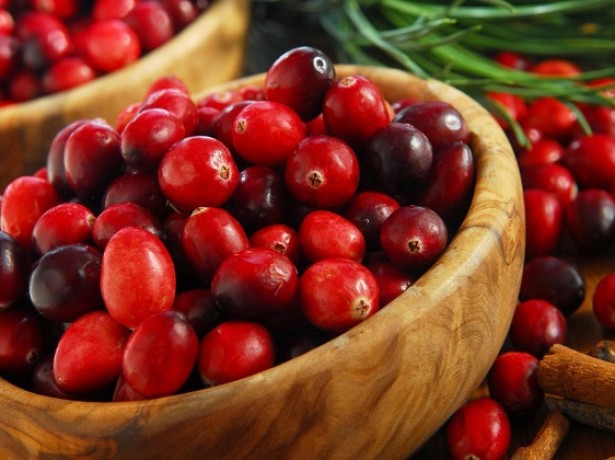
The berries, laid out in containers and filled with water, are pressed down with a wooden circle, on top of which a load is placed
Cranberry juice, as well as cranberry juice, are also easily stored without becoming sour or moldy. This is thanks to large doses of ascorbic and folic acid, which work as a natural preservative.
Cranberries in the forest and garden
Gardeners and naturalists have long tried unsuccessfully to grow swamp sweets in their own plots. As in the case of lingonberries and blueberries, it turned out that the European cranberry is a plant too dependent on the general ecosystem of the forest, which is why attempts to transfer it to the garden failed every time. Cultural forms of this forest delicacy appeared relatively recently, from the end of the 19th century in North America. Breeders developed the first successful varieties of garden crops based on large-fruited cranberries growing only there.
As it turned out, it is this species that best adapts to garden conditions and responds to watering with fertilizers with a significant increase in yield. Now there are a large number of different varietal groups and hybrids, varying in terms of ripening, yield, winter hardiness, and fruit size. Garden cranberries are also larger than wild cranberries and raise clusters of berries above the ground, which makes them easier to harvest industrially.
Previously, the main share of exports fell on the northern countries, where it is growing in abundance: Russia, Finland, Sweden. Nowadays, the collection of natural cranberries is not widespread. Modern agricultural industry fully satisfies the demand for it. The leader in the number of cranberry plantations and yields is the United States of America.
Video about cranberries in your garden
In terms of taste and beneficial properties, garden cranberries are practically in no way inferior to their swamp relatives. The only thing is that the current volume of harvesting does not allow storing and transporting the harvest the way residents of taiga villages do, soaking the berries, when all the beneficial properties and taste are preserved for a very long time. Nowadays, most often on store shelves you can find frozen cranberries, which, of course, taste blander and worse than fresh or pickled ones. Fresh berries are available for sale only during the harvest season. This is from October to January.
The ancient sailors knew about the benefits and healing power; they took it with them on voyages and used it as a remedy for scurvy and a cure for other diseases. The Indians lubricated meat with its juice, extending its shelf life, and also prepared a drink from the berries and treated various skin diseases.
Few people know how and where cranberries grow today, although the berry is a fairly common wild berry. By the way, it is practically unsuitable for growing in garden conditions - few people manage to grow it, since the berry has special requirements for climate and soil.
Types and distribution of cranberries
There are 3 types of cranberries - ordinary, large-fruited (American) and small-fruited (common only in Russia). Common cranberries can be found throughout Eurasia. She especially loves zones with a temperate climate.
Small-fruited cranberries grow in the north of Russia, where the conditions and climate are ideal for it. In general, cranberries are distributed throughout Russia (it’s not for nothing that they are famous as an original Russian berry), with the exception of the Caucasus, Kuban and the south of the Volga region.
In Europe, the sour and very healthy cranberry grows north of Paris, and in America, the habitat of large-fruited cranberries covers the northern USA and Canada.
As for living conditions, the common cranberry grows in moist soils, in swamps, in lowlands, and in hilly areas, preferring hollows with standing groundwater.
It must be said that the plant is extremely sensitive to the environmental situation and instantly reacts to human economic activity. In such places, cranberry bushes simply disappear.
Differences between types of cranberries
The common cranberry is an evergreen shrub with thin and flexible shoots reaching a length of 30 cm. The leaves on them are small, oblong, covered with waxy 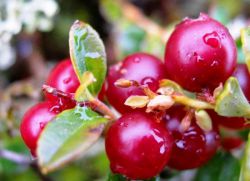 raid. Its flowers are pinkish or light purple. The fruits have the shape of an ellipse or a ball, up to 12 cm in size. Several hundred berries can grow on one bush in a season. The bush blooms in June, and can be harvested from September.
raid. Its flowers are pinkish or light purple. The fruits have the shape of an ellipse or a ball, up to 12 cm in size. Several hundred berries can grow on one bush in a season. The bush blooms in June, and can be harvested from September.
Small-fruited cranberries are in many ways similar to common cranberries, but their fruits are smaller.
The large-fruited or American cranberry looks different from its Eurasian relative. This species has two subspecies - erect and creeping. The berries are large in size - sometimes their diameter reaches 25 mm. These berries also differ in acidity – they have lower acidity.
Among the berries of the Heather family, cranberry is one of the most famous. In popularity and use, it is many times superior to its close relatives - blueberries, lingonberries and blueberries.
Common cranberry (marsh cranberry), large-fruited cranberry, small-fruited cranberry
Cranberry has two scientific Latin names that are used interchangeably. In Russian-language sources it is Oxycoccus, a generic Latin name consisting, paradoxically, of two Greek words “sour” and “berry”. The second scientific name assigned to the genus by Carl Linnaeus, who first described cranberries, is Vaccinium.
Scientists distinguish from three to five types of cranberries, these are small-fruited, large-fruited and ordinary cranberries. The common cranberry is called Vaccinium oxycoccus, the large-fruited cranberry is Vaccinium macrocarpon, and the small-fruited cranberry is Vaccinium microcarpum. Common cranberries are popularly called marsh cranberries; this name can sometimes be found in scientific sources - Oxycoccus palustris. In the world scientific literature, as a rule, they use the historical name of cranberry.
The popular names of cranberries are associated with the appearance of the plant. The flowering stems resemble the head of a crane on a long neck, which is why in English-speaking countries the cranberry was called craneberry. In Ukrainian, the name of cranberry is also associated with the crane - crane.
This name dates back to pagan times, when animals and birds were considered sacred. According to legend, one autumn, when the cranes were about to fly away to warmer climes, a young hunter snuck into the swamp and shot one bird. The crane took off, but could not fly far, and while it was flying, drops of blood fell on the marsh mosses and lichens. Veles, the patron saint of animals and nature, took pity on the bird and turned it into a well crane. And the drops of blood became berries, and remained to grow in the swamps among moss and lichen.
Description of cranberries
The life form of all types of cranberries is evergreen shrubs with creeping shoots that can take root. The length of the shoots can reach 25-35 cm. Thanks to this method of vegetative propagation, cranberries occupy large areas. Plants have a tap root system with numerous adventitious roots that develop on lying shoots.
All types of cranberries - small-fruited, large-fruited and ordinary - are mycotrophic plants that form a symbiosis with a soil fungus. The fungus receives organic substances that cranberries synthesize, and the plant, with the help of fungal hyphae, receives mineral soil components. Without mycorrhiza (interaction with the fungus), cranberries slow down and often die.
Cranberry leaves are whole, small, oblong or ovoid, arranged alternately. Leaf blade with pronounced dorso-ventral differences: dark green above and white below. An interesting feature of cranberry leaves is that they protect the stomata from water. Like all terrestrial plants, cranberry stomata, through which gas exchange occurs, are located on the underside of the leaf, while in floating aquatic plants (water lilies, Victoria regia) the stomata are located on the top. To prevent water from penetrating into the tissues of cranberry leaves growing in swamps during a change in level, they are covered from below with a thick waxy layer.
Cranberry flowers have a double perianth consisting of four sepals and four petals. There are eight stamens, arranged in two circles of four, the lower ovary consists of four sepals fused into one pistil. The color of cranberry petals varies from pink to dark pink or light purple. Long pedicels allow pollinating insects to better see flowers that are close to the ground.
Cranberries bear fruit in the second year. Its fruit is a four-locular, red berry, round or ellipsoid in shape, according to the number of carpels. The type of seed dispersal is ornitochory, reproduction by birds. Not only do they spread seeds over long distances, but after passing through the digestive tract of birds, cranberry seeds germinate better.
Small-fruited cranberries have smaller berries than common cranberries; their shape is elliptical and elongated, so they are almost never collected for consumption.
Where do cranberries grow?
Cranberry is a Holarctic species, distributed in the northern hemisphere. The common cranberry grows in Eurasia and North America. The natural habitat of large-fruited cranberries is the eastern part of the United States and Canada. But the berry was introduced to Europe, where the large-fruited cranberry acclimatized perfectly.
Small-fruited cranberries grow in Europe and Asia, reach Korea, grow in the Far East, and are found in the mountains (Carpathians, Urals). Small-fruited cranberry suffers most from habitat destruction, drainage of swamps, and development of wetlands. In some European countries, small-fruited cranberries are included in the Red Book.
In natural biocenoses, cranberries grow in swamps, in damp places, and in coniferous forests with a sphagnum lower layer. Frequent places for cranberry growth are sphagnum-sedge bogs fed by groundwater and raised bogs. Less commonly, cranberries grow on swampy shores of lakes or oxbow lakes. Common companions of cranberries are sphagnum (lichen, which I mistakenly call moss), real green mosses, various types of sedge, sedge, and dwarf birch.
On video: common cranberry
Properties of cranberries: benefits and contraindications
“There are no berries sour as cranberries” - probably many people remember these poetic lines from childhood. Fresh cranberries, picked in the fall, really have a bright, sour flavor. The presence of acids in berries determines many beneficial properties of cranberries and some contraindications.
Among the types of cranberries, the most commonly consumed are common cranberries (marsh cranberries) and large-fruited cranberries. The chemical composition of the berries of these two types is identical; the amounts of certain substances may fluctuate slightly. Slight differences in the amount of chemical components of cranberries can be observed in different varieties or places of growth. Fresh cranberries contain a lot of water, useful organic substances, vitamins, and microelements.
We recommend reading:
Organic ingredients
Simple carbohydrates: monosaccharides - mainly glucose and fructose, disaccharides - sucrose;
Polysaccharides (high molecular weight carbohydrates) – dietary fiber and pectin;
Organic acids – citric (predominant), malic, acetic, benzoic, oxalic, oleanic, quinic, ketoglutaric;
Anthocyanins (plant glycosides);
Catechins are compounds from the flavonoid group, strong antioxidants;
Betaine;
Phenolic acids;
Proteins;
Fats (very little).
Vitamins and vitamin-like substances
Vitamin A or retinol, fat soluble;
Beta-carotene, a precursor of vitamin A, a molecule of which in the body in the presence of fat breaks down into two molecules of vitamin A;
Vitamin B1 or thiamine is water soluble;
Riboflavin or B2 is water soluble;
Vitamin B3 – synonyms: niacin, nicotinic acid, vitamin PP;
B6, pyridoxine;
Folacin B9;
Vitamin C (ascorbic acid);
Vitamin E – tocopherol, fat-soluble;
Vitamin K is fat soluble.
Mineral components
Cranberries contain more than two dozen mineral components, which are divided into macro and microelements. Among macroelements, potassium ranks first; there is ten times more of it in berries than calcium, the second most abundant mineral component of cranberries.
Cranberries are also useful due to the presence of iron, magnesium, zinc and phosphorus in its composition. Microelements of cranberries are selenium, manganese, copper, molybdenum, iodine, boron and many others.
Contraindications for eating cranberries
Despite the invaluable benefits for cranberries, there are complete contraindications and partial ones (that is, restrictions on its use).
Due to the presence of a large amount of acids in the berries, cranberries should not be consumed by people suffering from various forms of gastritis, pancreatitis and high stomach acidity. If you have liver disease, cranberry consumption should be limited or completely avoided. It depends on the disease and its stage. For any diseases of the gastrointestinal tract, you should consult a doctor before consuming cranberries.
A contraindication for consuming cranberries is individual intolerance. Cranberries may cause allergic reactions in some people.
If you have sensitive tooth enamel that reacts to acid, you can only consume cranberries in their sweet form, and if this does not help, you should discard the berries so as not to destroy thin tooth enamel.
When are cranberries harvested?
The most useful cranberries are harvested in the fall, untouched by frost. Cranberries are harvested unripe and ripen later. Cranberries can be stored for a long time in a glass jar filled with plain cold water. During the ripening period (mid-September or October), cranberries are harvested on an industrial scale. Using special technologies, the berries are washed off with water without damaging the structure of the sphagnum bogs. Cranberry processors churn the water and the berries break off and float.
This harvesting method is used for large-fruited cranberries, inside of which there are small air pockets, thanks to which the berries float on the surface.
Cranberries are harvested by hand before frost and with the onset of frost. When the berries freeze a little, they become less sour.
The third stage of cranberry harvesting after the snow melts - this berry is the sweetest, but its vitamins are partially destroyed and organic acids disintegrate.
In mid-September, ruby beads are scattered across the moss cover of sphagnum bogs. The most valuable berry of the forest zone is ripening - marsh cranberry.
However, you can pick cranberries not only in September, but also later, until winter. And even in the spring, after the snow melts, they will remain in the swamps - snow cranberries, which are much sweeter than autumn ones. But there is no vitamin C left in them anymore.
Common cranberry, swamp
This is a plant from the heather family. A relative of lingonberries, blueberries, and heather.
In Russian swamps, common cranberry, otherwise called swamp cranberry, predominates. Distributed in the north of European Russia, Western and Eastern Siberia, Kamchatka and Sakhalin. And also in northern Europe.
In addition to common cranberries, small-fruited cranberries also grow in Eurasia. It is, however, more often recognized not as a separate species, but as a subspecies of the common one. And there is also a large-fruited cranberry, a predominantly American species, growing in the swamps of Canada.
Swamp cranberries naturally grow in swamps. In raised, sphagnum bogs. In transitional, sphagnum-sedge swamps. Found in swampy forests, tundra and forest-tundra.
Sphagnum moss is a constant companion of this most valuable berry. After all, it is he who creates these swamps. If you are interested in this very peculiar representative of the bryophyte department, please take a look at.
Everything about swamp cranberries is small and not very noticeable. Besides berries, of course. The leaves are tiny, the stems are thin and creeping.
However, it is a shrub. Thin, slightly thicker than ordinary thread, the stems are woody and very durable. Only the shoots of the current year remain soft and covered with fluff.
Each individual bog cranberry bush grows in one place for several decades. During this time, a pine tree in the forest grows into a multi-meter tree. And the creeping cranberry vines reach a length of almost a meter.
Cranberry is an evergreen plant. Its small leathery leaves with rolled edges overwinter under the snow. They are glossy, dark green above, whitish, covered with a waxy coating below.
Swamp cranberry is not too demanding on soil. And what kind of soil is there in the swamp? – Acidic, poor in nitrogen compounds.
But this is exactly what cranberries are happy with! Try to plant it in a well-fertilized bed - the plant will feel bad. For its successful growth, it will be necessary to bring peat from the high sphagnum bog. Moreover, provide excess watering.
But the swamp cranberry has irreplaceable helpers for life. Like all heathers, it forms mycorrhiza - a symbiotic community with fungi.
Fungal hyphae permeate the entire plant. The cranberry shares sugars produced during photosynthesis with the fungus. The fungus provides the shrub with nitrogen compounds.
It’s very beautiful in the sphagnum bog in May! Blooms include rosemary, wild rosemary, and palmate root. Swamp cranberries are also blooming.
The flowers are small, but elegant. On a thin peduncle, bell-shaped pale pink corollas rise above the moss hummocks. The stamens grow together into two pollen tubes. In the center of the flower there is a short pistil with a four-lobed ovary.
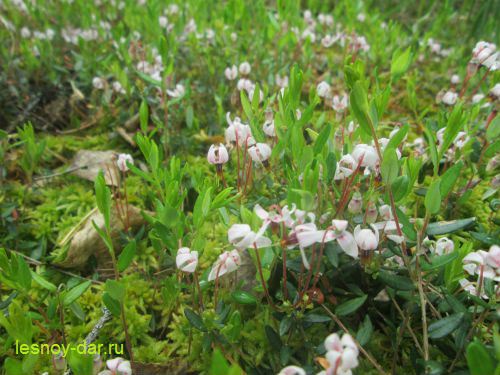
It seems that a thin melodic ringing can be heard. Or is it still the mosquitoes that are “ringing”?
In summer, berries are formed in place of flowers. They are white at first, but by the end of August they begin to turn red. The berries are round or oblong, and quite large - reaching a diameter of a centimeter or more.
The shrub can no longer hold them. And the berries scatter on greenish-yellow, whitish, sometimes reddish moss. Swamp cranberry is the healthiest berry in the northern forest.
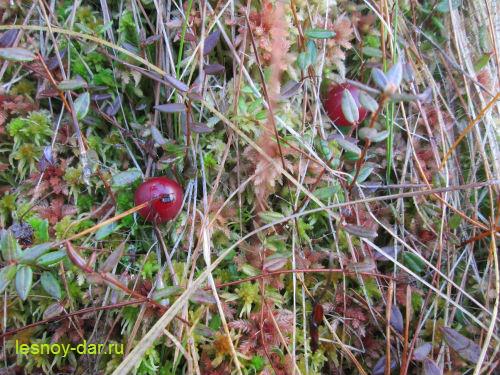
Sometimes called "northern grapes". For some reason the comparison doesn't seem particularly appropriate to me. But “northern lemon” is spot on!
Benefits of cranberries
Swamp cranberry has valuable nutritional and medicinal properties. In addition, this berry is unique in its preservation. It can stay fresh for almost a whole year. It is enough to sort out the berries and scatter them in a dry place. Benzoic acid in the berries prevents them from rotting.
Compotes, jams, jelly... Cranberries in their own juice... Puree with sugar... In sugar syrup... In powdered sugar. The use of berries is very diverse!
Excellent jams are made from cranberries. It’s even awkward to compare tasty and healthy cranberry juices and drinks with the “household chemicals” that grocery stores are filled with.
Cranberries are used both as a seasoning for meat dishes and as part of some salads. Add cranberries when sauerkraut - it will become both tastier and more beautiful on the plate.
In addition to homemade preparations, the berry is widely used by the food industry. Juices, jams, preserves, drinks, alcoholic beverages.
And let's not forget that marsh cranberry is a medicinal plant!
It tastes sour. The juice contains a high acid content. Citric acid predominates. That’s why it’s a “northern lemon”! There are benzoic and quinic acids. A lot of ascorbic acid is vitamin C.
As a source of vitamin C for the prevention of scurvy, marsh cranberry has only competition in the north.
Cranberry juice is indispensable for colds and flu. It has excellent antipyretic and tonic effects.
Cranberry juice, especially in combination with honey, treats coughs and sore throats.
Benzoic acid not only preserves the berries themselves. Its powerful bactericidal effect also benefits us.
Cranberry juice and fruit drinks are indicated for diseases of the kidneys and urinary tract, both acute and chronic. If the disease is caused by a bacterial infection, the natural antibiotic benzoic acid in combination with potassium counteracts it.
In addition, cranberry juice and fruit drinks help cleanse the kidneys, remove harmful substances from them, and prevent the formation of stones.
Cranberries also have the ability to lower blood pressure.
Contraindications for the use of cranberries ? Of course they exist.
Caution must also be exercised at low blood pressure.
But since ancient times, cranberry juices and fruit drinks have been a source of vitamins and a medicine for treating children. Especially for colds and various viral infections.
How to pick and store berries
Berries should be picked after they are completely ripe. And this happens no earlier than mid-September.
Collected immature, slightly reddened, they will, of course, turn red. How tomatoes picked green turn red. The only thing is that these berries spoil quickly. And as a therapeutic and prophylactic agent they are of no value at all!
It is best to pick berries by hand, “berry by berry,” choosing fully ripe, dark red, and largest ones. But that doesn’t usually happen! Most often, special scoops called “nabirushki” are used for collection.
However, these devices do not cause much harm to the plant itself, unlike lingonberries. Thin stems and small leaves easily slip between the teeth of the scoop, and large berries fall inside.
The collected berries are sorted, removing debris, unripe and damaged fruits. They can be stored fresh in a cool, dry place.
Sometimes the berries are poured with cold water and kept soaked. As the water evaporates, you just need to add it to the container.
Berries are also frozen and stored in the freezer in food-grade plastic bags.
During my childhood, the old people called this berry “crane fruit”. Interestingly, the English name for cranberry is Craneberry– means “crane berry”. And in North America, settlers from England sometimes called it Bearberries, which translates as “bear berries.”
Of course, bears and cranes feast on cranberries, as well as wood grouse, black grouse, hazel grouse, and partridges. Birds are the main consumers of fruits; they also spread cranberry seeds.
But... Take another look at the photo of the flower. Who or what does it remind you of?
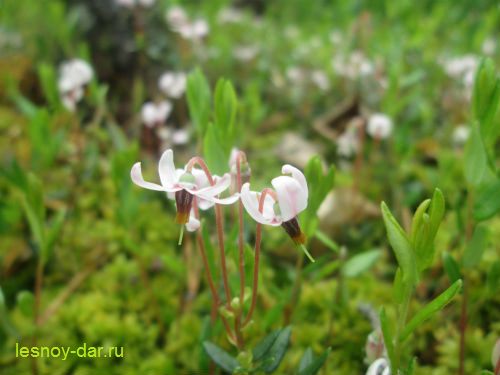
Swamp cranberry flowers
For some reason it looks like a bird's head with a beak. On the beak of a crane. Maybe this is where these words came from - craneberry, swamp cranberry?
Subscribe to news? Click on the picture!
 By clicking on the picture, you consent to the newsletter, the processing of personal data and agree with
By clicking on the picture, you consent to the newsletter, the processing of personal data and agree with
